名词,代词
- 格式:doc
- 大小:31.50 KB
- 文档页数:4
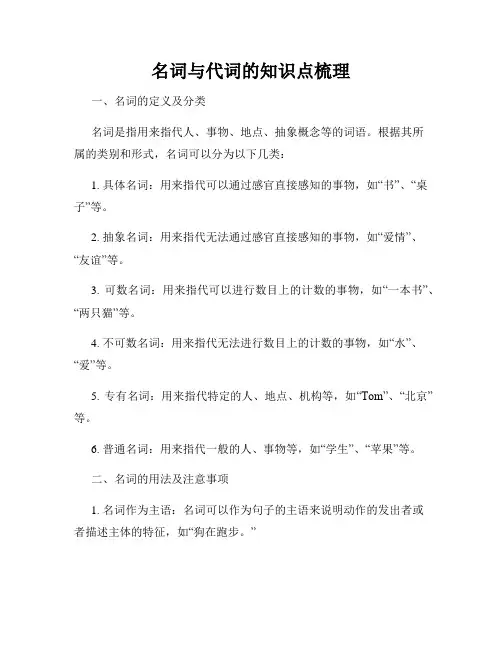
名词与代词的知识点梳理一、名词的定义及分类名词是指用来指代人、事物、地点、抽象概念等的词语。
根据其所属的类别和形式,名词可以分为以下几类:1. 具体名词:用来指代可以通过感官直接感知的事物,如“书”、“桌子”等。
2. 抽象名词:用来指代无法通过感官直接感知的事物,如“爱情”、“友谊”等。
3. 可数名词:用来指代可以进行数目上的计数的事物,如“一本书”、“两只猫”等。
4. 不可数名词:用来指代无法进行数目上的计数的事物,如“水”、“爱”等。
5. 专有名词:用来指代特定的人、地点、机构等,如“Tom”、“北京”等。
6. 普通名词:用来指代一般的人、事物等,如“学生”、“苹果”等。
二、名词的用法及注意事项1. 名词作为主语:名词可以作为句子的主语来说明动作的发出者或者描述主体的特征,如“狗在跑步。
”2. 名词作为宾语:名词可以作为句子的宾语来接受动作的影响或者描述动作的承受者,如“我喜欢电影。
”3. 名词作为定语:名词可以作为另一个名词的修饰语,用来描述被修饰名词的属性、特征等,如“树叶”、“学生证”等。
4. 名词作为补语:名词可以作为补语出现在谓语动词的后面,用来补充说明主语或宾语的身份、性质等,如“他是医生。
”5. 使用专有名词时首字母需大写,使用普通名词时首字母需小写。
6. 注意名词的单复数形式的变化,如“apple”(单数)和“apples”(复数)。
三、代词的定义及分类代词是指用来代替名词或名词性短语的词语。
根据其在句子中所代表的对象或代词的功能,代词可以分为以下几类:1. 人称代词:用来指代说话人、被说话人或者与说话人和被说话人相关联的第三者,如“我”、“你”、“他”等。
2. 物主代词:用来指代某个具体的所有者或凭借关系的拥有者,如“我的”、“你的”、“他的”等。
3. 指示代词:用来指代某个具体的事物或人,起指示作用,如“这”、“那”等。
4. 疑问代词:用来提出问题或表示怀疑,如“什么”、“谁”等。

名词与代词的区别及用法名词和代词在语法上都属于名词类词性,但它们在具体的用法和功能上有所区别。
本文将介绍名词和代词的区别,并探讨它们在句子中的常见用法。
一、名词的基本概念和用法名词是用来表示人、事物、动物、地点、抽象概念等具体或抽象的实体的词语。
它可以用来做主语、宾语、定语、表语等成分,还可以用来构成复合词和短语。
名词可以分为可数名词和不可数名词。
可数名词可以用单数和复数形式表示,而不可数名词通常只有单数形式。
例如,可数名词:"book"(书),复数形式是"books";不可数名词:"water"(水),没有复数形式。
名词在句子中的不同位置和用法可以通过以下例句来说明:1. 主语:"The cat is sleeping."("猫正在睡觉。
")2. 宾语:"I like apples."("我喜欢苹果。
")3. 定语:"The red car is mine."("那辆红色的车是我的。
")4. 表语:"She is a teacher."("她是一位教师。
")名词也可以用来构成复合词和短语,例如:"birthday party"(生日派对)、"coffee shop"(咖啡店)等。
二、代词的基本概念和用法代词是用来代替名词或名词词组的词语,在句子中可以发挥名词的作用。
代词分为人称代词、物主代词、指示代词、疑问代词、关系代词、不定代词等。
1. 人称代词:用来表示说话人、被说话人或与被说话人有关的人或事物。
例如:"I"(我)、"you"(你)、"he"(他)、"she"(她)、"they"(他们)等。
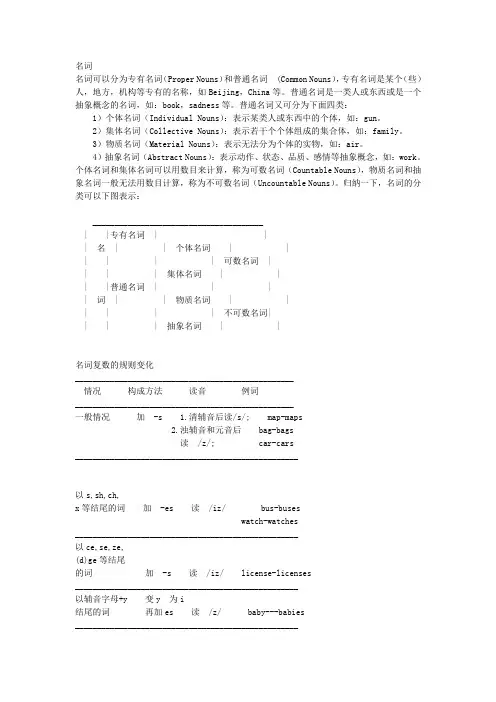
名词名词可以分为专有名词(Proper Nouns)和普通名词(Common Nouns),专有名词是某个(些)人,地方,机构等专有的名称,如Beijing,China等。
普通名词是一类人或东西或是一个抽象概念的名词,如:book,sadness等。
普通名词又可分为下面四类:1)个体名词(Individual Nouns):表示某类人或东西中的个体,如:gun。
2)集体名词(Collective Nouns):表示若干个个体组成的集合体,如:family。
3)物质名词(Material Nouns):表示无法分为个体的实物,如:air。
4)抽象名词(Abstract Nouns):表示动作、状态、品质、感情等抽象概念,如:work。
个体名词和集体名词可以用数目来计算,称为可数名词(Countable Nouns),物质名词和抽象名词一般无法用数目计算,称为不可数名词(Uncountable Nouns)。
归纳一下,名词的分类可以下图表示:_______________________________________| |专有名词| || 名| | 个体名词| || | | | 可数名词|| | | 集体名词| || |普通名词| | || 词| | 物质名词| || | | | 不可数名词|| | | 抽象名词| |名词复数的规则变化__________________________________________________情况构成方法读音例词__________________________________________________一般情况加-s 1.清辅音后读/s/; map-maps2.浊辅音和元音后bag-bags读/z/; car-cars___________________________________________________以s,sh,ch,x等结尾的词加-es 读/iz/ bus-buseswatch-watches___________________________________________________以ce,se,ze,(d)ge等结尾的词加-s 读/iz/ license-licenses___________________________________________________以辅音字母+y 变y 为i结尾的词再加es 读/z/ baby---babies___________________________________________________其他名词复数的规则变化1) 以y结尾的专有名词,或元音字母+y 结尾的名词变复数时,直接加s变复数:如:two Marys the Henrysmonkey---monkeys holiday---holidays比较:层楼:storey ---storeys story---stories2) 以o 结尾的名词,变复数时:a. 加s,如:photo---photos piano---pianosradio---radios zoo---zoos;b. 加es,如:potato--potatoes tomato--tomatoesc. 均可,如:zero---zeros / zeroes3) 以f或fe 结尾的名词变复数时:a. 加s,如:belief---beliefs roof---roofssafe---safes gulf---gulfs;b. 去f,fe 加ves,如:half---halvesknife---knives leaf---leaves wolf---wolveswife---wives life---lives thief---thieves;c. 均可,如:handkerchief:handkerchiefs / handkerchieves名词复数的不规则变化1) 以y结尾的专有名词,或元音字母+y 结尾的名词变复数时,直接加s变复数:如:two Marys the Henrysmonkey---monkeys holiday---holidays比较:层楼:storey ---storeys story---stories2) 以o 结尾的名词,变复数时:a. 加s,如:photo---photos piano---pianosradio---radios zoo---zoos;b. 加es,如:potato--potatoes tomato--tomatoesc. 均可,如:zero---zeros / zeroes3) 以f或fe 结尾的名词变复数时:a. 加s,如:belief---beliefs roof---roofssafe---safes gulf---gulfs;b. 去f,fe 加ves,如:half---halvesknife---knives leaf---leaves wolf---wolveswife---wives life---lives thief---thieves;c. 均可,如:handkerchief:handkerchiefs / handkerchieves不可数名词量的表示1)物质名词a. 当物质名词转化为个体名词时。

名词与代词的用法详解一、名词的基本用法名词是指用来表示人、事、物、地点、抽象概念等的词语。
它在句子中可以担任主语、宾语、表语、定语、状语等成分。
下面我们来详细讲解名词的用法。
1. 主语名词可以作为句子的主语,说明动作的执行者或者状态的存在。
例如:- 猫喜欢捉老鼠。
- 这本书很有趣。
2. 宾语名词可以作为句子的宾语,接受动作的影响或者具体说明动作的对象。
例如:- 我喜欢篮球。
- 她读了一本好书。
3. 表语名词可以作为句子的表语,说明主语的特征、性质、身份等。
例如:- 我是学生。
- 这个花园很美丽。
4. 定语名词可以作为句子的定语,修饰其他名词,限定或说明它的范围、性质等。
例如:- 我们去了一家好饭店。
- 那个大城市非常繁华。
5. 状语名词可以作为句子的状语,表示时间、地点或方式等。
例如:- 他在公园里散步。
- 我们一起去看电影。
二、代词的基本用法代词是用来代替名词的词语,用于避免重复或者指代已知的事物或概念。
根据其使用情况和功能,代词可分为人称代词、物主代词、指示代词、疑问代词、不定代词等多种类型。
人称代词用来代替特定的人或事物,分为第一人称、第二人称和第三人称。
例如:- 我喜欢读书。
- 你是我的好朋友。
- 他们正在比赛。
2. 物主代词物主代词用来表示事物的归属关系,分为所有格和宾格两种形式。
例如:- 这是我的书。
- 那是你的手机。
3. 指示代词指示代词用来指示离说话人或与说话人有关的人或事物,分为近指示和远指示两种。
例如:- 这是我刚买的新车。
- 那些花是我的妈妈种的。
疑问代词用来提问特定的人、事、物或概念。
例如:- 你想要什么礼物?- 这是谁的手机?5. 不定代词不定代词指代不确定的人或事物,具有不明确的特指对象。
例如:- 有人在敲门。
- 我想吃点东西。
总结:名词和代词在句子中有着不同的用法,名词可以作为主语、宾语、表语、定语、状语等,用来表示人、事、物、地点、抽象概念等;而代词则是用来代替名词,避免重复或者指代已知的事物或概念。
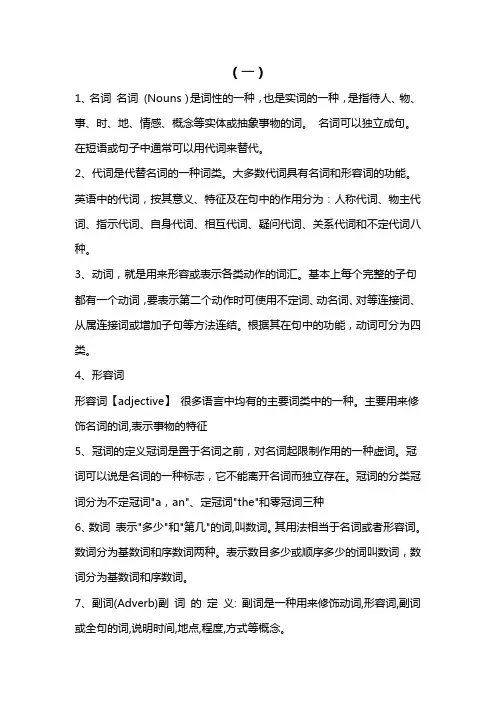
(一)1、名词名词(Nouns)是词性的一种,也是实词的一种,是指待人、物、事、时、地、情感、概念等实体或抽象事物的词。
名词可以独立成句。
在短语或句子中通常可以用代词来替代。
2、代词是代替名词的一种词类。
大多数代词具有名词和形容词的功能。
英语中的代词,按其意义、特征及在句中的作用分为:人称代词、物主代词、指示代词、自身代词、相互代词、疑问代词、关系代词和不定代词八种。
3、动词,就是用来形容或表示各类动作的词汇。
基本上每个完整的子句都有一个动词,要表示第二个动作时可使用不定词、动名词、对等连接词、从属连接词或增加子句等方法连结。
根据其在句中的功能,动词可分为四类。
4、形容词形容词【adjective】很多语言中均有的主要词类中的一种。
主要用来修饰名词的词,表示事物的特征5、冠词的定义冠词是置于名词之前,对名词起限制作用的一种虚词。
冠词可以说是名词的一种标志,它不能离开名词而独立存在。
冠词的分类冠词分为不定冠词"a,an"、定冠词"the"和零冠词三种6、数词表示"多少"和"第几"的词,叫数词。
其用法相当于名词或者形容词。
数词分为基数词和序数词两种。
表示数目多少或顺序多少的词叫数词,数词分为基数词和序数词。
7、副词(Adverb)副词的定义: 副词是一种用来修饰动词,形容词,副词或全句的词,说明时间,地点,程度,方式等概念。
8、介词的定义和特征介词是一种用来表示词与词, 词与句之间的关系的词。
在句中不能单独作句字成分。
介词后面一般有名词代词或相当于名词的其他词类,短语或从句作它的宾语。
(二)1、名词,人或事物的名称3、代词,代替名词或者数词(比如some就是代替数目)3、动词,动作或状态4、数词,表示数目或顺序(比如序数词,5th就是表示顺序)5、形容词,人或事物的性质或状态(因为形容词一般修饰名词)6、副词,动作的特征或性状特征(因为副词一般修饰动词或形容词)7、冠词,表示名词的泛指或特指8、介词,表示名词或代词与其他词的关系(因为介词后面一半紧跟名词,代词或其他名词性结构)9、连词,连接词与词,短语与短语,句子与句子10、感叹词,表示说话时的感情或语气(三)1、adj. / a. 形容词用来描述一类物质的性质,状态,外貌,或人的性格特点,性质,品格如:big,happy2、adv. / ad. 副词用来修饰动作或形容词,一般在句子中做状语用表示动作的进行怎样,或表示程度,特点,如:clearly,happily3、prep. 介词连接地点,时间的一类词语,可以表示方位,时间.跟一些表示时间,地点的词连用表示介词词组如:in,to,on,under4、conj. 连词用来连接时间,地点,原因,结果的一类词语如:when,beacuse,so5、num. 数词表示数字的词,既可以是基数词,也可以是序数词如:one,two,first6、int. 感叹词表示感叹的一类词,一般不加一解释,只代表感叹如:what,how,haurray7、vt. 及物动词(后面要加宾语)行为动作的词如:do,finish,play8、vi. 不及物动词(后面不加宾语)表示行为动作的词如:appear9、n. 名词表示物体,物质的词如:pig,cow,man10、pron. 代词代指一类人,事或物的词如:he,she,hers,his,things11、art = 冠词,article的缩写(四)在英语语法中主要把词分为8大类:1.名词:表示人、物或地方等,如:John,teacher;table,pen;London;beauty.2.代词:用来代替名词,以避免重复某个名词,如:I,you,it,that,those,them.3.形容词:用来修饰或限制某个(些)名词,如:good(man),white (paper),every(book),much(water),(John is)hon-est,(He seems)lazy.被修饰或限制的名词,叫做主体词(head-word)。
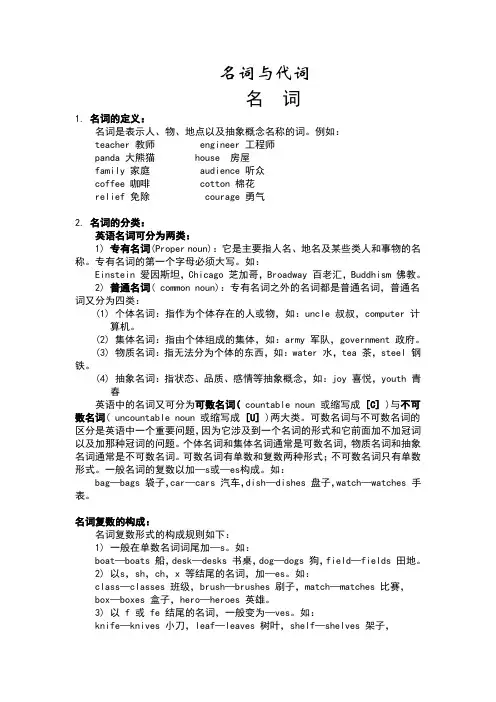
名词与代词名词1. 名词的定义:名词是表示人、物、地点以及抽象概念名称的词。
例如:teacher 教师 engineer 工程师panda 大熊猫house 房屋family 家庭 audience 听众coffee 咖啡 cotton 棉花relief 免除 courage 勇气2. 名词的分类:英语名词可分为两类:1) 专有名词(Proper noun):它是主要指人名、地名及某些类人和事物的名称。
专有名词的第一个字母必须大写。
如:Einstein 爱因斯坦,Chicago 芝加哥,Broadway 百老汇,Buddhism 佛教。
2) 普通名词( common noun):专有名词之外的名词都是普通名词,普通名词又分为四类:(1) 个体名词:指作为个体存在的人或物,如:uncle 叔叔,computer 计算机。
(2) 集体名词:指由个体组成的集体,如:army 军队,government 政府。
(3) 物质名词:指无法分为个体的东西,如:water 水,tea 茶,steel 钢铁。
(4) 抽象名词:指状态、品质、感情等抽象概念,如:joy 喜悦,youth 青春英语中的名词又可分为可数名词( countable noun 或缩写成[C] )与不可数名词( uncountable noun 或缩写成[U] )两大类。
可数名词与不可数名词的区分是英语中一个重要问题,因为它涉及到一个名词的形式和它前面加不加冠词以及加那种冠词的问题。
个体名词和集体名词通常是可数名词,物质名词和抽象名词通常是不可数名词。
可数名词有单数和复数两种形式;不可数名词只有单数形式。
一般名词的复数以加—s或—es构成。
如:bag—bags 袋子,car—cars 汽车,dish—dishes 盘子,watch—watches 手表。
名词复数的构成:名词复数形式的构成规则如下:1) 一般在单数名词词尾加—s。
如:boat—boats 船,desk—desks 书桌,dog—dogs 狗,field—fields 田地。
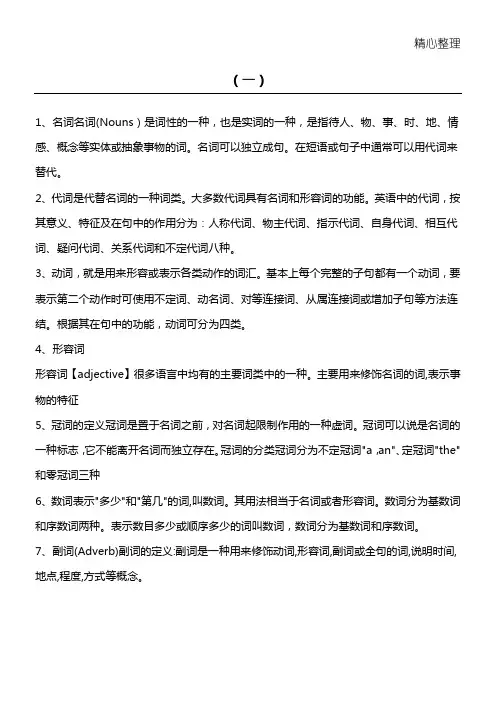
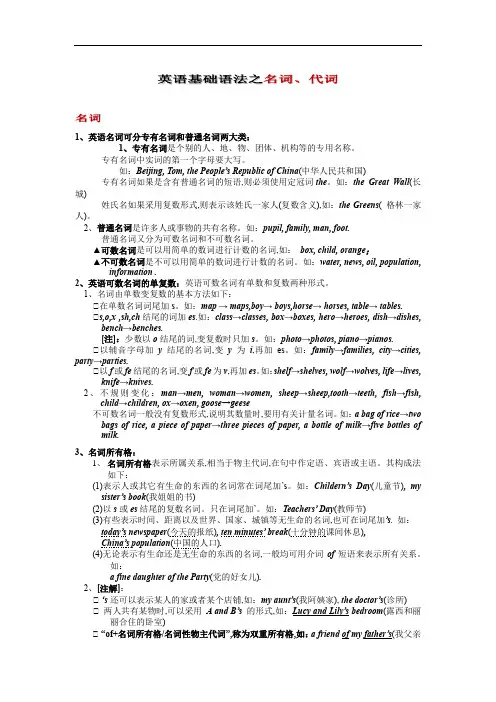
1、英语名词可分专有名词和普通名词两大类:1、专有名词是个别的人、地、物、团体、机构等的专用名称。
专有名词中实词的第一个字母要大写。
如:Beijing, Tom, the People’s Republic of China(中华人民共和国)专有名词如果是含有普通名词的短语,则必须使用定冠词the。
如:the Great Wall(长城)姓氏名如果采用复数形式,则表示该姓氏一家人(复数含义),如:the Greens( 格林一家人)。
2、普通名词是许多人或事物的共有名称。
如:pupil, family, man, foot.普通名词又分为可数名词和不可数名词。
▲可数名词是可以用简单的数词进行计数的名词,如:box, child, orange;▲不可数名词是不可以用简单的数词进行计数的名词。
如:water, news, oil, population, information .2、英语可数名词的单复数:英语可数名词有单数和复数两种形式。
1、名词由单数变复数的基本方法如下:①在单数名词词尾加s。
如:map → maps,boy→ boys,horse→ horses, table→ tables.①s,o,x ,sh,ch结尾的词加es.如:class→classes, box→boxes, hero→heroes, dish→dishes,bench→benches.[注]:少数以o结尾的词,变复数时只加s。
如:photo→photos, piano→pianos.①以辅音字母加y结尾的名词,变y为i,再加es。
如:family→families, city→cities, party→parties.①以f或fe结尾的名词,变f或fe为v,再加es。
如:shelf→shelves, wolf→wolves, life→lives,knife→knives.2、不规则变化:man→men, woman→women, sheep→sheep,tooth→teeth, fish→fish,child→children, ox→oxen, goose→geese不可数名词一般没有复数形式,说明其数量时,要用有关计量名词。

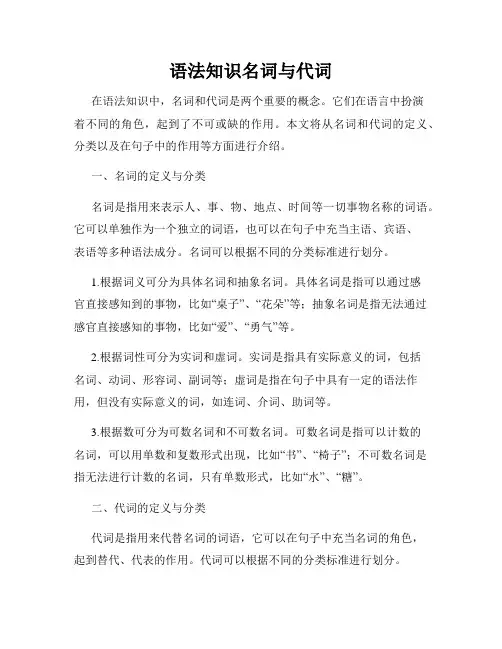
语法知识名词与代词在语法知识中,名词和代词是两个重要的概念。
它们在语言中扮演着不同的角色,起到了不可或缺的作用。
本文将从名词和代词的定义、分类以及在句子中的作用等方面进行介绍。
一、名词的定义与分类名词是指用来表示人、事、物、地点、时间等一切事物名称的词语。
它可以单独作为一个独立的词语,也可以在句子中充当主语、宾语、表语等多种语法成分。
名词可以根据不同的分类标准进行划分。
1.根据词义可分为具体名词和抽象名词。
具体名词是指可以通过感官直接感知到的事物,比如“桌子”、“花朵”等;抽象名词是指无法通过感官直接感知的事物,比如“爱”、“勇气”等。
2.根据词性可分为实词和虚词。
实词是指具有实际意义的词,包括名词、动词、形容词、副词等;虚词是指在句子中具有一定的语法作用,但没有实际意义的词,如连词、介词、助词等。
3.根据数可分为可数名词和不可数名词。
可数名词是指可以计数的名词,可以用单数和复数形式出现,比如“书”、“椅子”;不可数名词是指无法进行计数的名词,只有单数形式,比如“水”、“糖”。
二、代词的定义与分类代词是指用来代替名词的词语,它可以在句子中充当名词的角色,起到替代、代表的作用。
代词可以根据不同的分类标准进行划分。
1.根据代替范围可分为人称代词、物主代词、指示代词、疑问代词、不定代词等。
人称代词是指用来代替特定人称的代词,如“我”、“你”、“他”等;物主代词是指用来代替特定物主的代词,如“我的”、“你的”、“他的”等;指示代词是指用来指示特定事物的代词,如“这个”、“那个”等;疑问代词是指用来提问特定事物的代词,如“谁”、“哪个”等;不定代词是指用来代替不确定事物的代词,如“一些”、“任何”等。
2.根据词性可分为人称代词、反身代词、指示代词、相互代词等。
人称代词是指用来代替人的代词,如“他”、“她”、“我们”等;反身代词是指用来表示动作反射到自己身上的代词,如“自己”、“他们自己”等;指示代词是指用来指示事物的代词,如“这个”、“那个”等;相互代词是指表示两个或多个人或物之间相互关系的代词,如“彼此”、“互相”等。

名词代词知识点总结大全名词和代词是英语中非常重要的语法组成部分,它们用来表示人、事物、地点等。
在学习英语的过程中,对于名词和代词的正确使用和搭配是非常关键的。
下面我将对名词和代词的知识点进行总结。
一、名词的定义和分类名词是表示人、动物、植物、事物、地点、现象、抽象概念等的词,一般用来表示人或事物的名称。
名词分为以下几种类型:1.具体名词具体名词是指可以看、摸、听、闻或者数的事物的名称,主要分为以下几类:a) 个体名词:表示一个实际存在的人或事物,如:book(书)、table(桌子)、dog(狗)等。
b) 集体名词:表示由多个个体组成的整体,但作为一个整体来看待,如:family(家庭)、team(队伍)、class(班级)等。
c) 物质名词:表示没有生命的物质,如:water(水)、sand(沙)、paper(纸)等。
2.抽象名词抽象名词是指没有具体形象的概念或感情的名称,如:happiness(幸福)、love(爱)、freedom(自由)等。
3.专有名词专有名词是指专指某一特定的人、地点或事物的名称,如:China(中国)、Tom(汤姆)、Beijing(北京)等。
二、名词的数名词有单数和复数之分。
一般来说,名词变复数时有以下几种形式:1.一般情况下,在名词后加-s,如:book(书)→books(书籍)。
2.以-s、-ss、-sh、-ch结尾的名词,在名词后加-es,如:bus(公共汽车)→buses(公共汽车)。
3.以辅音字母+y结尾的名词,将y变为i,再加-es,如:city(城市)→cities(城市)。
4.以-o结尾的名词,加-es,如:tomato(西红柿)→tomato es(西红柿)。
5.以-f或-fe结尾的名词,将f或fe变为v,再加-es,如:leaf(叶子)→leaves(叶子)。
6.特殊变化,如:man(男人)→men(男人)、woman(女人)→women(女人)。
第一节:名词与代词1.名词的种类专有名词:特指人或事物的名称,首字母需要大写,包括人名,地名,书名,月份,星期,组织机构名称等。
如:Barack Obama 奥巴马September 九月Europe 欧洲the United Nations 联合国Wednesday 星期三普通名词:泛指一类人或事物的共有名称。
普通名词又分为四种:个体名词,集体名词,物质名词和抽象名词。
(1)个体名词:表示单个人或事物。
Child 孩子teacher 老师school 学校Company 公司street 街道city 城市(2)集体名词:表示多个人或事物的总称Crew 全体人员police 警察people 人们Youth 青年人furniture 家居cattle 牛(3)物质名词:表示物质的名称,包括表示材料、液体、气体、食物、饮料等名词Gold 金子ink 墨水wind 风Sugar 糖sand 沙子food 食品(4)抽象名词:表示抽象概念的名称,包括表示性质、状态、情感等的名词Progress 进步happiness 幸福kindness 善良Knowledge 知识anger 愤怒hatred 仇恨2.名词的数:即可数名词和不可数名词1)可数名词:有单数和复数之分;名词复数的构成方法有规则和不规则变化a.规则变化①绝大数的名词复数是在名词后直接加sMap ------ book----- grade ------Play------ face----- house-----②以字母s, sh, ch, x 结尾和以辅音字母+o 结尾的名词变复数时加—esBus----- dish--- inch----Box---- hero--- tomato---Potato--- volcano- ---③以字母f或fe 结尾的名词变成复数形式时,要把f或fe 改为v ,再加—esLife---- leaf---- half------Knife----- shelf ----- handkerchief---PS: belief----- gulf----- roof----Safe----④以辅音字母+y 结尾的名词变成复数形式时,要把y 改成i, 再加-esStory--- baby--- country-----b.不规则变化①改变单数名词中的元音字母Man-- foot--- woman---Tooth--- goose---②单,复数形式相同Sheep dear③特殊形式Child--- ox---- mouse---Phenomenon---- datum--- criterion---④表示“某国”人的名词单数、复数形式因习惯而各异A.单复数形式相同a Chinese -----two Chinese a Japanese---two JapaneseB.词尾加-sRussian GermanC.变man为menAn Englishman-----two Englishmen a Dutchman----two Dutchmen(3)复合名词的复数形式①写成一个词且不含连字符者,通常在第二部分加复数词尾。
英语单词词性分类:名词和代词的区别与
联系
- 名词是指表示人、物、地点、概念等具体或抽象事物的词语。
名词通常可以用作主语、宾语、定语和补语等,用于构建句子的各
个成分。
- 代词是指用来代替名词或名词短语的词语。
代词起到代替特
定事物或成分的作用,可以帮助简化句子并避免重复。
名词的特点
- 名词可以表示具体的人、物、地点等,例如:dog(狗)、book(书)、London(伦敦)。
- 名词可以表示抽象的概念、状态或品质等,例如:love (爱)、happiness(幸福)、beauty(美丽)。
- 名词可以单数形式和复数形式出现。
单数形式指一个人或物,复数形式指多个人或物。
代词的特点
- 代词可以替代一个或多个名词,避免重复使用。
例如:He (他)代替名词John(约翰)。
- 代词可以分为人称代词、物主代词、指示代词、不定代词等
不同种类。
- 代词可以用来指示特定的人或物(指示代词),表达所属关
系(物主代词),或用于特定句子结构中的定语从句和主语从句等。
名词和代词的联系
- 名词和代词都可以用来表示人、物、地点和概念等。
- 名词和代词都可以在句子中充当不同的语法角色,例如主语、宾语、定语和补语等。
- 在一些情况下,代词可以替代特定名词,实现简化句子的效果。
因此,虽然名词和代词有一些共同点,但它们之间仍存在一些
明显的区别。
名词更侧重于表示具体或抽象事物,而代词则更侧重
于替代和简化句子中的名词成分。
在学习和使用英语时,准确理解
和正确使用名词和代词的区别是很重要的。
名词和代词的区别及用法解析名词和代词是语法中常用的两种词类,它们在句子中起到类似的作用,但它们之间也有一些明显的区别。
本文将对名词和代词的区别及其用法进行解析。
一、名词的定义和用法解析名词是指代表人、事、物、地点等实际存在的词语。
它可以具体表示某个特定对象,也可以抽象表示某种概念或性质。
在句子中,名词通常作为主语、宾语、表语、定语、状语等成分的一部分。
名词的主要特点包括可数性和不可数性。
可数名词可以单数形式和复数形式,表示可数物体的数量,例如:book(单数)- books(复数);而不可数名词表示不可分割的物质、抽象概念或集合概念,不能用于复数形式,例如:water(水)、information(信息)等。
名词还可以进行所有格的表示,用来表示某物属于某人或某物的关系。
一般在名词后面加上“'s”或“of”来表示所有格,例如:John's book (约翰的书)、the book of the teacher(老师的书)。
二、代词的定义和用法解析代词是用来代替名词或名词短语的词语。
它可以用来避免重复使用名词,简化表达。
代词在句中具有名词的功能,可以作为主语、宾语、定语等成分。
代词分为人称代词、物主代词、指示代词、反身代词、疑问代词、不定代词等不同类型。
1. 人称代词:用来指代人的词语,包括主格和宾格两种形式。
主格包括I、you、he/she/it、we、they,宾格包括me、you、him/her/it、us、them。
例如:I am a student.(我是一名学生。
)2. 物主代词:用来表示所属关系,包括形容词性和名词性两种形式。
形容词性物主代词包括my、your、his/her/its、our、their,修饰名词时位于名词前;名词性物主代词包括mine、yours、his/hers、ours、theirs,可以单独作为一个名词使用。
例如:This book is mine.(这本书是我的。
中文有八大詞類,分別是:名詞、代名詞、形容詞、動詞、副詞、介系詞、連結詞、驚嘆詞。
一、名詞:人、地、物、動植物、概念等一切有形或無形的名稱。
◎林肯是美國歷史上一位非常傑出的總統。
(「林肯」、「美國」、「歷史」、「總統」都是名詞)◎誠實是一種美德。
(誠實、德)◎狗躺在樹下。
(狗、樹)二、代名詞:代替名詞的字或詞。
◎我昨天遇見他們。
(「我」、「他們」都是代名詞)◎那些發亮的是什麼?(那些、什麼)◎我的比他的好很多。
(我的、他的)三、形容詞:直接或間接修飾名詞或代名詞的字詞。
◎他看到一位美麗的姑娘。
(「美麗的」是形容詞)◎那個胖胖的學生很聰明。
(胖胖的、聰明)◎今天的功課又多又難。
(多、難)四、動詞:說明人或物的動作、存在、狀態的字詞。
◎我們走過這條大街。
(「走」是表示動作的動詞)◎他一餐吃兩碗飯。
(「吃」是表示動作的動詞)◎小明是中學生。
(「是」是表示狀態的動詞)◎花園裡有兩隻蝴蝶。
(「有」是表示存在的動詞)五、副詞:修飾動詞、形容詞及其他副詞的字詞。
(副詞可分別表示時間、地方、頻率、程度、情況、肯定、否定等等。
「的」通「地」。
)◎他跑得非常的快。
(「非常的(地)」、「快」都是副詞,表示程度。
)◎小明家距學校有多遠?(多,程度副詞)◎老師講得很慢但很清楚。
(很、慢、清楚,程度副詞)◎展昭非常的神勇。
(非常的(地),程度副詞)◎他昨天去台南看球賽。
(昨天,時間副詞)◎小弟弟不會寫字。
(不,否定副詞)◎小明常常去公園散步。
(常常,頻率副詞)六、介系詞:放在名詞或代名詞之前,表示該名詞與其他字詞的關係。
介系詞又稱介詞或前置詞。
◎他坐在椅子上。
(「在……上」是介詞,表示他和椅子的關係)◎在門邊的那輛腳踏車是老王的。
(「在……」表示腳踏車和門的關係)◎我從口袋裡掏出一張鈔票。
(「從……」表示我和口袋的關係)◎他站在我旁邊。
(「在……」表示他和我的關係七、連接詞:將字、詞或句子相互連接的字詞。
◎小明和小英是同班同學。
一、名词概念:是表示人、事物、抽象概念等的词。
根据其词汇意义分为专有名词和普通名词。
1.普通名词:表示一类人、东西、抽象概念的名词例如:表示东西、事物book/tree/computer表示一类人boy/girl/teacher/father/man/ woman表示抽象概念,像人的感情,品质,精神happiness/trouble/ 练习:辨析那些是名词,那些不是computer, take, book, new, actor, run, water, coffe, table, age, sell, sport, bring2.专有名词:表示人、地方、机构、组织等专有名称,具体来说,它包括人名、国家、地名、月份、星期、节日、书名、电影名以及某些抽象名词等。
例如:Jim吉姆 China中国 Mr. Smith 史密斯先生 July七月Friday星期五 the Yellow River黄河 Christmas圣诞节English 英语 A Tale of Tow Cities双城记二.名词的数1.可数名词(单数和复数的变化)可数名词复数规则变化:(1)一般情况在词尾加-S book---books desk---desks 等。
(2)以s, x, sh, ch等结尾的名词,通常加-es: bus-buses box-boxes match-matches watch-watches dish-dishes练习:There are many_____(bus) and____(car) on the street.I have two______(watch),so I give a______(watch)to my sister.(3)以y结尾的名词,其复数构成要分两种情况:以”辅音字母+y”结尾的名词,将y改为ies;如:city-cities, baby-babies以“元音字母+y”结尾的名词,直接加-s如:toy-toys holiday-holidays(4以f或fe结尾的名词,多数变f或fe为v加es如:wife-wives , knife-knives, leaf-leaves(树叶), life-lives(生命)记住以下10个单词要把f或fe改成v加es的单词:Wife(妻子) , life(生命), knife(小刀), leaf(树叶), thief(贼),half(一半),self(自己),shelf(架子),wolf(狼)但注意:roof-roofs(屋顶)是例外(5)以“辅音字母+o”结尾的名词,加 es如tomato-tomatoes, potato-potatoes, hero-heroes(黑人英雄爱吃番茄和马铃薯)以“元音字母+o”结尾的名词,加S如radio-radios, piano-pianos注意:photo-photos(相片)练习:写出下列单词的复数Friend photo radio cat leaf key toy box zoo city tomato bus roof tree baby new potatoknife leaf单复数同形:people, Chinese, Japanese, fish deer sheepThere are__________________ in the river.We have____________________for lunch.名词复数不规则变化(没有规则,需特别记忆)Man/men woman/women child/children tooth/teeth foot/feet goose/geese mouse/mice一些以man, woman结尾的合成词,变复数时与man, woman的变化形式相同Policeman, Englishman…There are twelve months in a year .January is the first month of the year二、代词1、概念:代词是代替名词的一种词类。
用来代替上文中提到过的人或物。
大多数代词具有名词和形容词的功能。
2、分类: 按其意义、特征及在句中的作用分为:人称代词:主格I, you, she, he, it, we, you, they,宾格 me, you, her, him, it, us, you, them做主语用主格,做宾语、表语时用宾格,但是在强调句中,用作主语例如:I like apple.They go to school everyday.He likes her.在省略谓语的句子中,用作主语的人称代词常用宾格。
Who is on duty today.Me.两个以上的人称代词并列时,其次序排列原则: 二三一人称. “我”总是放在最后, 在并列主语中,排列顺序为:you, she/he and I, 并列宾格: you, her/ him and meYou, she and I will be in charge of the case.Mr. Li asked you, Tom and me to clean the windows物主代词:既有表示所属的作用又有指代作用adj性 my, your, her, his, its, our, your, their,n性 mine, yours, hers, his, its, ours, yours, theirsadj 物主代词属于限定词, 后面必须有n, 只能作定语。
n 性物主代词在用法上相当于“adj 词性物主代词+n”This isn’t her pen. Hers looks newer and cleaner.主语I lost my bike, Can I use yours.宾语Look for your keys in your bag, not in mine.介词宾语: 双重属格为:a/an, this, that …+n +of +n 性物主代词a friend of mine. each brother of his.形容词 own 常用在形容词性物主代词后面加强语气one’s own+ 名词=.名词of one’s ownI have my own car/ friends =I have a car /friends of my own.I saw it with my own eyes !含有物主代词的词组on one’s own=by oneself 独立地,独自地try / do one’s best to do sth竭尽全力做某事lose one’s way / temper /life. 迷路/发脾气/丧命lose one’s heart to sb/ sth=fall in love with …钟情于in one’s forties/ fifties 在某人40 / 50来岁的时候do one’s homework 做作业;in one’s opinion 依某人看be one’s own master / mistress 独立自主keep / lose one’s balance( 因保持/失去平衡而) 稳住/倒下Keep / lose one’s head 保持镇定/昏头,冲动Keep / break one’s promise 信守/违背诺言keep / break one’s word 守信 /失信,食言eat one’s words 承认自己说错话on one’s way to spin one’s free/ spare time 在某人的闲暇时光hold one’s breath 屏息; lose one’s breath气喘吁吁to one’s surprise/disappointment令某人惊讶/失望的是指示代词:this, that, these, those,this , these 一般指时间或空间上较近的人或物;that, those 常指时间或空间较远的人或物。
指示代词的句法功能: 作主语、宾语、介词宾语:1.This is the best way to do learn English.2 I like this better than that.3 I don‘t want to talk about that.指示代词的特殊指代功能:1.介绍别人时要用this is; This is Miss Li. This is Tom2.this 常指下文中要讲到的事物,有启下的作用;that 则指上文中提到过的人/事物有承上的作用。
I want to tell you this: The party will be put off.He hurt his leg yesterday. That's why he didn't come.3.打电话时“你”“我”不用“you”“I”而要用that, thisA: Who is that? B: This is Lily speaking.4.若用于指代与前面提及的同类事物, 若该n的修饰语在后, 则多用that (单数n和不可数n ), those(复数n);The traffic on Humin Road is heavier than that on Guilin R.The weather in Beijing is drier than that in Shanghai.The book on the desk is as new as the one / that on the shelf.The ears of a rabbit are longer than those of a fox.5.that和those可作定语从句的先行词, those常用来指人We are looking for those who sing and dance well.Those who always work hard are sure to succeed指示代词还可作限定词:That boy is Bob. These trees are ours.this morning / afternoon /evening / week / month / Wednesday / autumn / year / term。